A few years ago my husband, Dennis, bought me a spiffy new nest box equipped with a nestcam for my spring birthday. Within two days several violet-green swallows (tachycineta thalassina) began checking it out. I’d expected an extended looky-loo period because that’s what happened the spring before when swallows nested under the eaves of our garden shed. But this time they took only four days to decide. After all, this site had the makings of prime birdy real estate: a clear view of the sky, wood chips in the bottom (we’d been trying to entice a woodpecker), and flying bugs everywhere!
The female, with intermittent help from the male, soon started building a nest with dried grasses and sticks. Clearly a fussy decorator, she arranged them with great care, then started fashioning the deep cup that would hold her eggs. Because of the nestcam I was able to watch her fancy foot work and acrobatics as she built the nest cup inside the box. Later she brought in feathers to line the cup. For the next few weeks, the first thing I did every morning was turn on the tv. And not to watch Oprah.
By the end of May the mother swallow was sleeping overnight in the nest box, usually retiring for the night just after sundown and leaving, I surmised, at dawn, long before I was up. The first few evenings, I spent hours watching her in the nest after dark, and noticed she did a lot of scratching. (Of course, she didn’t know a voyeur was watching her every move. I probably do a lot more scratching behind closed doors than in public!) At the same time, I got worried about the light in the nest, which was just as brightly-lit at midnight as it was at noon. Wouldn’t that disturb her sleeping pattern? But when I asked a nestcam expert, I learned that the light is infra-red and therefore invisible to the bird. The nest is actually completely dark inside all the time. Whew! Then one morning I noticed she was breathing very heavily, the pulse on the top of her neck racing. Again I worried. (This was as bad as being a new mother!) Was something wrong? But no, when she left the nest a while later, I realized I had been watching her lay another egg!
Three weeks after the mama started sleeping in the box, she finished laying her clutch of three gorgeous white oval eggs. For the next two weeks she spent most of the day and night in the box, exiting only to grab flying insects. In the nest, she spent her time scratching and turning the eggs, nature’s way of ensuring that they develop according to plan. Then, during the third week of June, two eggs hatched, and the next day the final two! After that the mother swallow had her hands full. Between catching flying insects, bringing them to the nest, getting the babies to open their mouths (for the first few days, while their eyes were still closed, she cheeped to get them to gape), dropping the insects into their white-flanged mouths, brooding, keeping the nest box clean, and removing material from the nest as the babies grew, she never stopped. The male, darker and slimmer than the female, also fed the babies, stood guard near the box, and sometimes removed material from it.
Watching this drama unfold was fascinating but a tad nerve-wracking. Knowing that many nestlings don’t make it, I had all kinds of things to fret about. Would a bird of prey find and kill the nestlings? Would our resident squirrel damage the nest? (He didn’t – but he did get dive-bombed every time he stopped for a drink at the bird bath.) Would a brown-headed cowbird lay her egg in the nest? My biggest worry, though, was that one particularly assertive baby always seemed to be at the head of the food line. I wondered if the mother was somehow keeping track of who’d been fed and who hadn’t. But all four babies seemed to be thriving, so I decided to believe that the parents knew what they were doing. That way I could get a good night’s sleep.
After two weeks the nestlings started to venture beyond the nest cup, which filled about half the nest box. Whenever the mother came in she’d push them all back into the cup, significantly relieving my anxiety. But then they started sitting, precariously I thought, in the doorway of the box.
I was petrified that one would fall out, and asked Dennis to get a ladder ready in case we had to rescue a fallen baby. But again, my fears were never realized.
During the final few days in the nest the babies began stretching their wings out wide, touching both walls, apparently eager to get out of there. They also started pecking at each other much too often for my liking. Then, at 8 am one July day, one baby fledged as I watched on screen. I immediately set up camp on the porch, binoculars in hand. Within an hour the baby that had been sitting in the doorway watching his sibling and parents flying nearby – and sometimes stopping in the tree to cheep at him – took the leap. But after a brief flying lesson, he perched on a bare branch in a tall tree for about two hours, where the mother continued to feed him. Eventually he flew off with her. The final baby was still in the nest at dark. Perhaps reticent to leave their little brother or sister alone (or for a completely different reason that I’ll never know), two of the fledged swallows returned to the nest for the night. The next day the number of swallows in the nest changed from hour to hour, and the mother visited the nest often during this ‘will-I-or-won’t-I’ interlude. By nightfall all four were back!
Finally, two days later, I woke to an empty nest, and felt like a proud grandma. In the world of nature and nestcams, though, things don’t always go so well. I’ll share that tale next month.



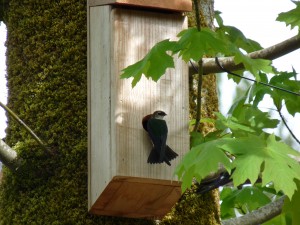
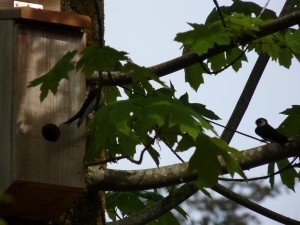
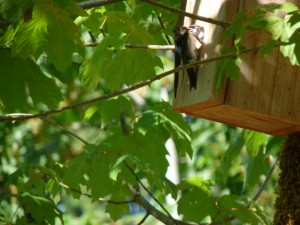
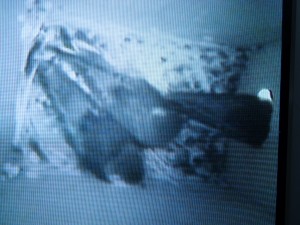
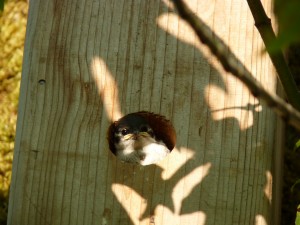
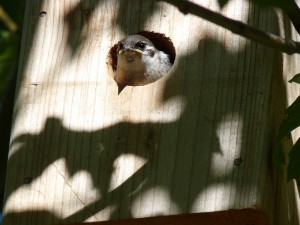
Charlotte – Yes, it is neat. And addictive!
You’re welcome Henry! Glad you enjoyed reading the post …
It would be so neat to have a bird box with a nest cam inside, and you would see such a different perspective of birds’ are doing!
Very exciting. Thanks for sharing.